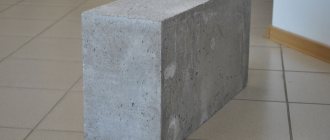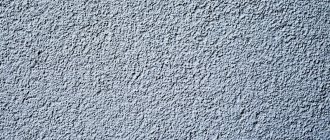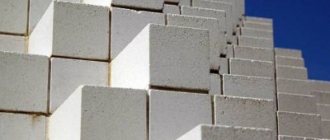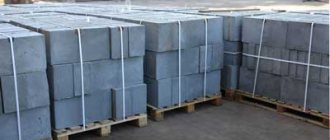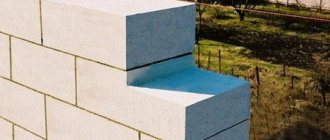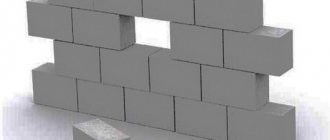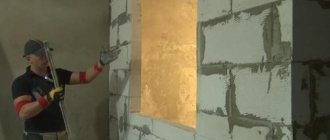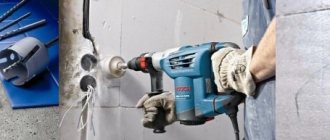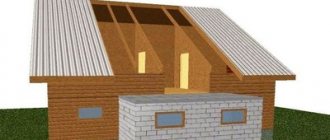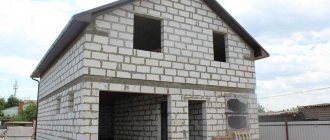Among other types of building materials used in the construction of the frame of a private house, foam concrete blocks are distinguished by their low cost, low thermal conductivity and low weight. Due to the extreme simplicity of the manufacturing technology, they can be made directly on the site in the utility room.
However, to build your own personal cottage, it is better to purchase foam blocks in a factory-made version with standard sizes and the brand required for a particular case. It is recommended to take some foam concrete products for external walls, and others for internal partitions.
What to look for when choosing?
In order to choose the most suitable one for your task from all the varieties of foam concrete blocks, you should pay attention to 5 main properties.
Size
In the first section we already talked about the standard dimensions of foam blocks, but 60*30 is not the only option for foam blocks. Based on the length, width and thickness, a material is selected for a specific task:
- For reliable external walls along the contour of the building - 60*30*20 or 60*40*20. In the second case, construction will go a little faster.
- For durable internal floors bearing the main load - 60*30*20.
- For ordinary interior partitions - 60*30*10.
Advice! When making a purchase, choose material made by one manufacturer, preferably in one batch. This is a guarantee of the same geometry, the same raw materials used, standard technical characteristics.
Structure
The appearance of each individual foam block must be uniform, the structure must also be uniform, with round rather than oval air bubbles. Cracks, chips, and other damage are unacceptable.
To check whether the supplier is saving on materials and whether the manufacturing and processing process is being followed, rub a small piece of foam block in your hand. Did the pebble crumble into sand? The product is not suitable for construction work.
Density
Along with the density of foam blocks comes thermal insulation. The relationship between the characteristics is inverse: the higher the density (kg/m2), the lower the thermal insulation index. And vice versa. By the way, sound insulation increases with density.
- For wall insulation, “soft” foam blocks with a rating of D500 or less and relatively low thermal conductivity are suitable. They are cheaper than analogues and perfectly maintain stable temperature and moisture levels.
- For load-bearing type partitions, bricks marked D1000 and higher are used. Large costs are paid off by a number of advantages in the form of strength and durability.
- Foam blocks D500-D1000 are average, used for the construction of low-rise buildings and interior floors. Unlike structural ones, they have a lower cost; in comparison with thermal insulation, they have a high density.
Frost resistance
Measured in cycles, main marks: F15, F35, F50, F75. Cyclicity shows the possibility of maintaining structure during temperature fluctuations. The higher, the more frost-resistant the foam block in front of you. The choice depends on the conditions of the region:
- southern regions with a mild climate, warm winters - up to 35;
- central Russia - 35-50;
- northern regions, Siberia - 50-75.
Manufacturer
As we have already mentioned, working with foam blocks is relatively easy - you can even produce the building material yourself. Therefore, a huge number of companies, both Russian and foreign, are engaged in the production of foam blocks. To choose the best supplier, pay attention to how long it has been on the market and what reputation it has - on the Internet you can find lists of the best and most popular manufacturers.
It is best to work with large factories, but to be sure of the quality of the products, be sure to ask the sellers of foam blocks for quality certificates.
From year to year the following participate in the ratings:
- XELLA;
- Aerostone;
- LSR;
- UDK;
- Aeroc;
- Stonelight;
- Bonolite.
Conclusion: buy foam blocks from one trusted manufacturer, choosing a product from one batch. Inspect the building material before purchasing for uniformity of color and structure. Choose a type that suits its technical properties.
Technical characteristics of foam blocks
When choosing, it is recommended to pay attention to the following technical characteristics of the foam block:
- Frost resistance. Determined by the number of cycles (freezing/thawing, 1 cycle - 1 change of seasons with a decrease in the average daily temperature to a marginal negative value) that the material can withstand. The frost resistance of foam concrete differs depending on the quality of the components used and the type of foaming agent. Minimum – F15, maximum – F75 b F100. Blocks with frost resistance of 75 cycles can be used in the Arctic Circle.
- Density. It determines the grade of material, is measured in kg per cubic meter and varies between 300–1200 kg/m3.
- Thermal conductivity. Depends on the brand of products and ranges from 0.09–0.38 W/m* °C.
- Weight. At normal humidity, 1 block weighs from 8.5 to 47 kg, depending on density.
- Foam block size. It is up to 600 mm in length, from 200 to 400 in width, and 90–300 mm in thickness. It is worth noting here that the production technology makes it possible to produce products of any size, but in private low- or multi-story construction it is recommended to rely on the size table GOST 21520–89. We’ll look at the typical dimensional indicators in more detail below.
It is important. The main characteristic of foam concrete, which determines its purpose, is density, calculated as the ratio of mass to volume of the block. In the marking it is designated by the letter D.
What types are there?
Different foam blocks differ from each other in quality indicators, appearance, and scope of use.
According to manufacturing technology there are:
- Molded foam blocks. The cement composition is poured into separate small molds or one large one with partitions.
- Cut foam blocks. A huge layer of foam concrete is poured and dried, which is cut with a special apparatus into foam blocks of the required size. Cut foam blocks have better natural geometry, but are more expensive.
By composition:
- Natural. Mixtures based on silicate glue, caustic soda, and natural pine rosin act as foaming agents. Bricks with a natural composition are denser and more reliable.
- Synthetic. Chemicals, such as PB-Lux, Rospen, PB-2000, are cheaper than natural analogs, but produce more voluminous foam, so the foam block turns out to be “loose”.
By structure:
- Standard. Brick made of solid foam concrete.
- Reinforced. The foam block is reinforced with fiber consisting of polypropylene - the second name is fiber foam block. It is characterized by increased strength.
By properties:
We have already talked about them earlier.
- Structural. Dense, cold.
- Thermal insulation. Less dense, warm due to large air cavities.
- Structural and thermal insulation. Medium density, with an average level of thermal conductivity.
By scope:
- Exterior walls. Large, thick.
- Internal load-bearing. Smaller, thinner than the previous ones.
- Internal non-load-bearing. Thin (10-15 cm).
Summary
Before drawing a conclusion regarding the main characteristics of foam blocks, it is worth noting that this building material is often identified with aerated concrete. Which is logical: their production technologies are similar, their properties are similar, even the state standards that regulate the requirements for their quality are the same. Only the structure and process of their production differ.
When creating foam block materials, a foaming agent is added to the already prepared mixture to increase its size (foam is formed, the material is filled with closed cells). Aerated concrete is produced through a chemical reaction - a foaming component (aluminum shavings) is added immediately, and when mixed (sand, cement and water), it gasifies it. As a result, cells are also formed, but they are not as uniform as those of foam concrete.
Returning to the types of foam block, it is worth noting that its size and weight are not only important characteristics when choosing products (for a specific project). Being standardized values, they allow you to accurately determine the need for building materials:
- count the number of products in a row of masonry (the length of all sides of the house box divided by the length of the block);
- determine the number of rows in the wall (divide the height of the wall by the height of the block);
- multiply the number of products in a row and the number of rows, add 10–15% of the stock - and you can order a complete set.
The only important clarification: the weight of products may vary depending on the level of humidity and production technology, and the dimensions are not accurate for everyone. Therefore, before purchasing, it is always useful to make sure that you are dealing with a proven, reliable supplier who offers only high-quality building materials and guarantees that their characteristics comply with the declared parameters.
Areas of application
Foam concrete blocks cover a lot of construction tasks, including:
- Construction of load-bearing walls. Simply put, the construction of low-rise (up to 3 floors) buildings.
- Redevelopment of premises. Thin foam blocks are an ideal material for partitions: lightweight, cheap, easy to use.
- Thermal insulation. The least durable foamed concrete is an excellent insulator of heat. It is placed as a second layer on the wall or floor. Foam blocks are also used to insulate floors between floors, openings under the roof, and load-bearing walls (for example, in corner rooms).
The following are built from foam blocks:
- residential buildings in any climatic (and even seismic!) zones: foam blocks do not burn, have high resistance values;
- outbuildings: a garage or barn can be erected in a matter of days;
- commercial buildings: warehouses, offices, small shops.
Pros and cons of houses made of foam concrete blocks
The advantages are as follows:
- The sizes of foam blocks standardized by GOST - simplifies the calculations of estimates and the work of masons;
- Cheap - foam concrete is one of the most cost-effective materials for building a house outside the city;
- Ease of processing - an ordinary hacksaw is enough to cut to the desired size;
- Durability - from them you can build a reliable and durable cottage three floors high, without using a reinforced concrete reinforcing frame;
- Light in weight – even the largest blocks can be worked alone without the use of special equipment;
- Excellent thermal insulation performance - houses made of foam blocks are considered one of the warmest; they outright outperform solid ceramic bricks in terms of heat transfer.
Foam concrete blocks are environmentally friendly and fire-resistant materials. The walls of houses made from them naturally “breathe,” which greatly simplifies maintaining a comfortable microclimate in the home. Here only log houses can compete with such cottages. However, in terms of fire resistance, wood is definitely not a competitor to foamed concrete.
Foam blocks also have disadvantages, but there are only two of them:
- High level of moisture absorption;
- Limited choice of type of foundation for the house (it must be strip or with a reliable grillage).
The main disadvantage of foam concrete is its predisposition to absorb moisture. There is no way to leave masonry without a protective finish. This applies to both interior decor and exterior façade.
Carefully check the quality of foam blocks: low-quality material may crack
When comparing the pros and cons of this building material, do not forget about the foundation underneath it. For houses made of foam blocks, the foundation will have to be made reliable and expensive. These concrete “bricks” themselves are quite light. However, the masonry of them must lie on a flat monolithic support so that, due to the movement of the soil at one of the corners of the structure, it does not crack from below to the roof.
What is a foam block and how is it produced?
Foam block, also known as gas block, also known as gas silicate block, is a building material made of cellular concrete. You can often find information online that foam block and gas block are different materials. There is some truth in this.
The foam block has a cellular structure
Foam blocks are materials made using a non-autoclave method, while gas blocks are products that are subject to heat treatment during manufacturing. Another difference is the method of foaming the concrete. Foam concrete is foamed with foaming agents, and aerated concrete with gas, which is actively released during a chemical reaction.
But, at present, the division into foam concrete and aerated concrete is irrelevant, since manufacturers of non-autoclave blocks began to add a small amount of gas-forming agents to the composition.
Therefore, in order not to get confused, it is more correct to say “autoclaved foam block/gas block” or “non-autoclaved foam block/gas block”. Next, we will briefly consider both technologies for manufacturing cellular blocks.
Autoclaved
Manufacturing of autoclaved foam block:
| Illustrations | Manufacturing stages |
Preparing and mixing ingredients:
| |
| Filling the form. The finished solution is poured into molds, where it is shaken, as a result of which the gas-forming agents are evenly distributed throughout the entire mass of concrete. | |
| Preliminary heat treatment. The poured molds are sent to a pre-hardening chamber for several hours, where at a temperature of 40 degrees the solution is saturated with gases, as a result of which it foams and increases in volume, and then gains strength. | |
| Mechanical restoration. After gaining strength, the massif is removed from the mold and cut into blocks using sandblasting. Then the grooves are cut using special equipment. | |
| Autoclaving. The formed blocks are sent to autoclaves, where they gain strength at a temperature of 180 degrees and a pressure of 12 atmospheres. |
Non-autoclaved
The manufacturing process of non-autoclaved foam block is much simpler:
| Illustrations | Actions |
| Mixing components. At the first stage, a mixture of cement, sand, foaming agent, additives and, of course, water is prepared. | |
| Filling forms. The finished mixture is poured into molds. | |
| Durability set. The solution poured into molds gains strength without heat treatment. | |
I’ll say right away that a non-autoclaved foam block is inferior to an autoclaved one in all respects, except price. Therefore, not a single large enterprise is engaged in the production of non-autoclaved gas blocks.
If you find a non-autoclaved foam block on sale, then know that it was made in artisanal conditions. I recommend using it only for outbuildings. And the point here is not only that without processing in autoclaves the material becomes less durable.
A non-autoclave unit is inferior in quality to an autoclave one
In artisanal conditions it is very difficult to make high-quality foam concrete, as it is very “capricious”. Changes in ambient temperature or proportions of ingredients immediately affect quality. Therefore, if you want to build a house, do not even consider non-autoclaved foam block as a possible wall material.
The structure of a foam concrete partition
Foam blocks for partitions are laid according to a similar principle as brick. Initially, it is worth determining whether the partition foam block is suitable for the task. The material is based on foam concrete with high insulating qualities, but low load-bearing abilities. It is practical to use and durable.
Partitions made of foam blocks
The characteristics of foam concrete blocks give the material numerous advantages:
- when laying partitions from foam blocks, the masonry is done very simply and with minimal time, the process is 2 times faster than building from brick;
- It has good sound insulation and heat insulation properties and is easy to process. If the dimensions of the foam blocks for partitions are not suitable for the intended purpose, then you can always easily cut off part of the element;
- It’s easy to drill a hole inside for wires or pipes;
- helps to realize the design idea:
- multifaceted shapes, rounded arches, etc., due to its flexibility in processing with a hacksaw;
- due to the large thickness of the partitions and the blocks themselves, a doorway can be cut into them;
- foam blocks, and foam concrete in general, are suitable for decorative treatments:
- sanding, laying heavy tiles, plastering surfaces, applying wallpaper, etc.;
- resistant to temperature changes, chemical and biological liquids, moisture, and exposure to ultraviolet light;
- the low price of the material makes it accessible to the masses;
- does not lead to a large load on the foundation or supports.
When laying partitions made of foam blocks, the masonry is very simple and takes minimal time.
The disadvantage of the material is the likelihood of obtaining specimens with a curved shape. High demands are placed on the surfaces of blocks, but only in relation to elements manufactured in production conditions, where GOST applies to sizes and shapes. If the purchase is made in underground workshops, it is better to buy more than the required number of blocks.
Video description
A visual comparison of foam blocks and gas blocks in the video:
- Gas block is 3-4 times stronger than foam block (if we compare brands with equal density); the plaster lays on it more evenly. At the same time, aerated concrete easily absorbs and releases moisture. With the same density, the foam block floats on the surface of the water, while the aerated concrete block is partially submerged in the water.
- The porosity of aerated concrete is more uniform than that of foam concrete, this is due to the peculiarities of production. Due to pores of different sizes, the thermal conductivity of different foam concrete blocks may differ.
- A wall made of foam blocks absorbs moisture more slowly than a wall made of gas blocks. But both facades need protection from direct contact with water.
- Aerated concrete is made from natural ingredients. In the production of foam blocks, foaming agents of synthetic origin are used, which can be harmful to human health.
Application of assembly adhesive Source besplatka.ua
- Foam concrete blocks are more profitable (cheaper) than aerated concrete ones. But more money will be spent on cement mortar for masonry than on glue.
